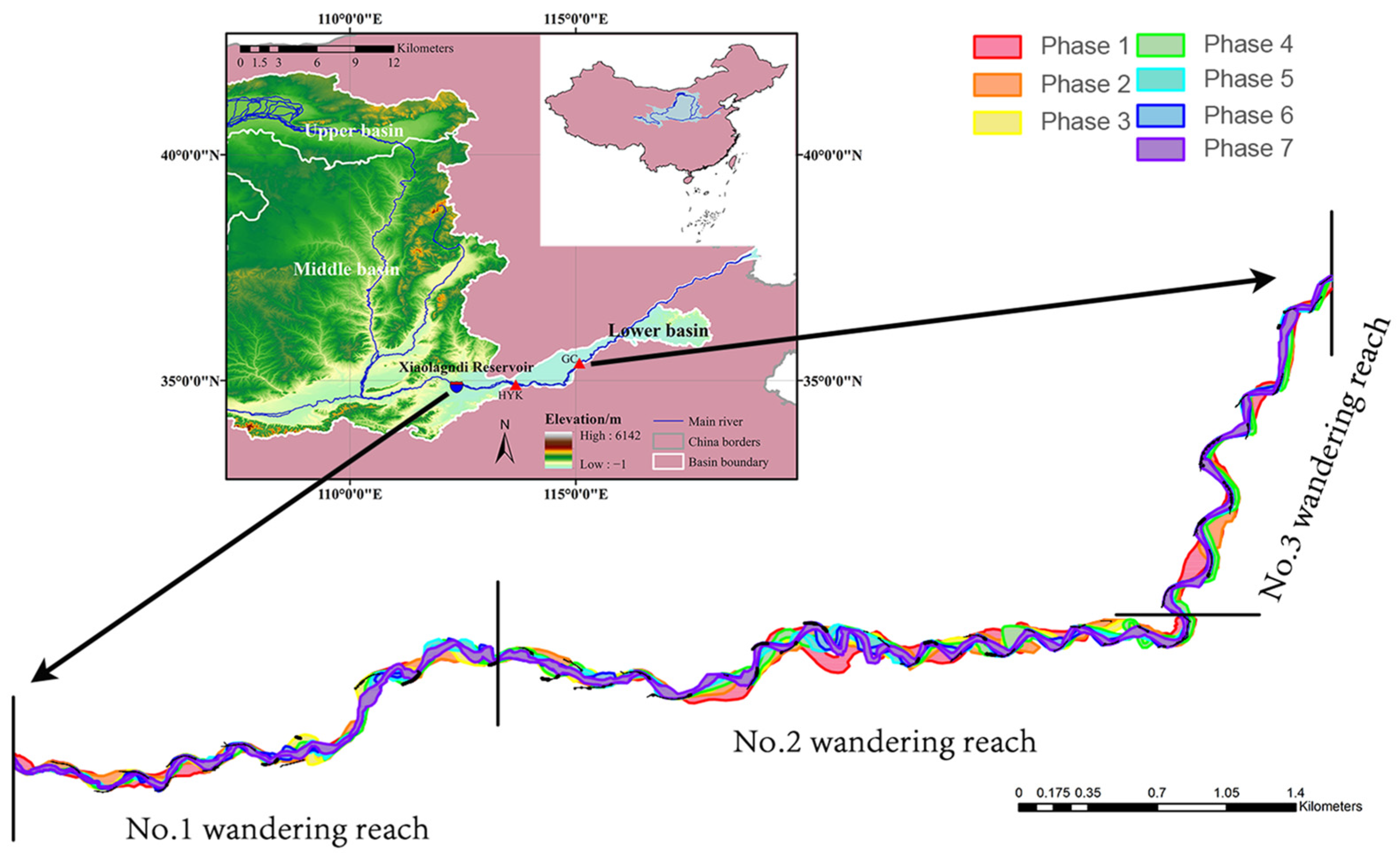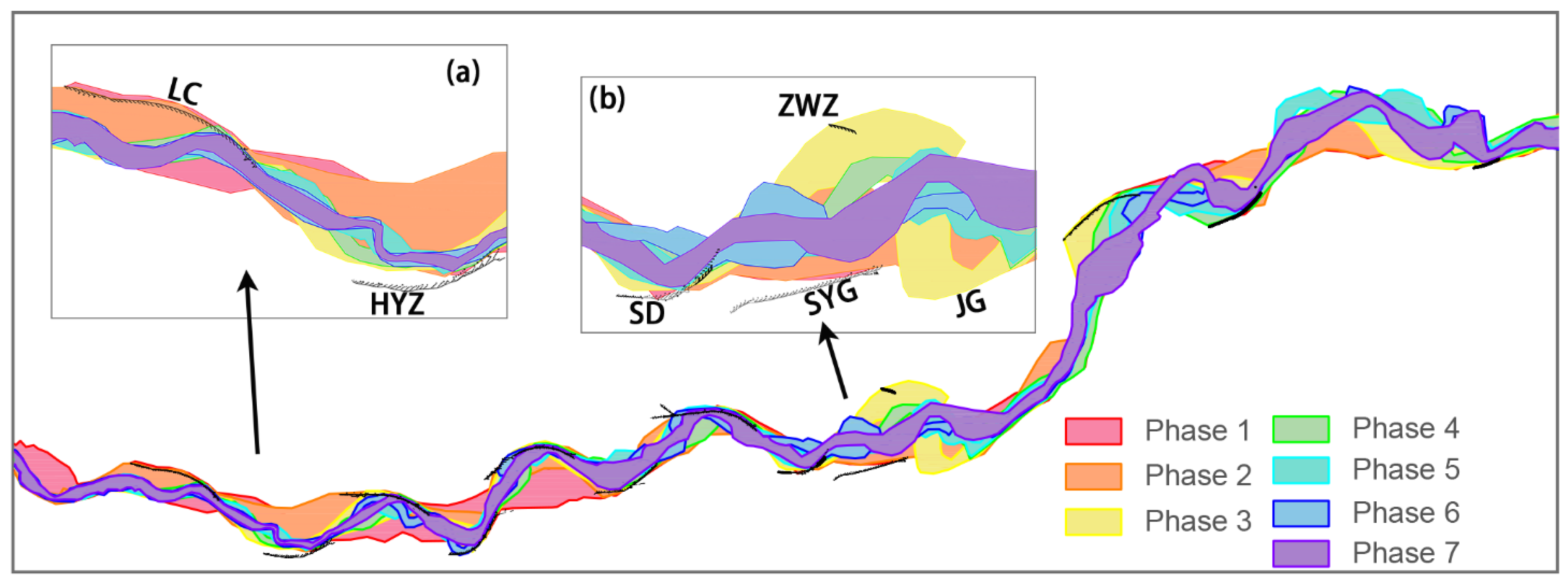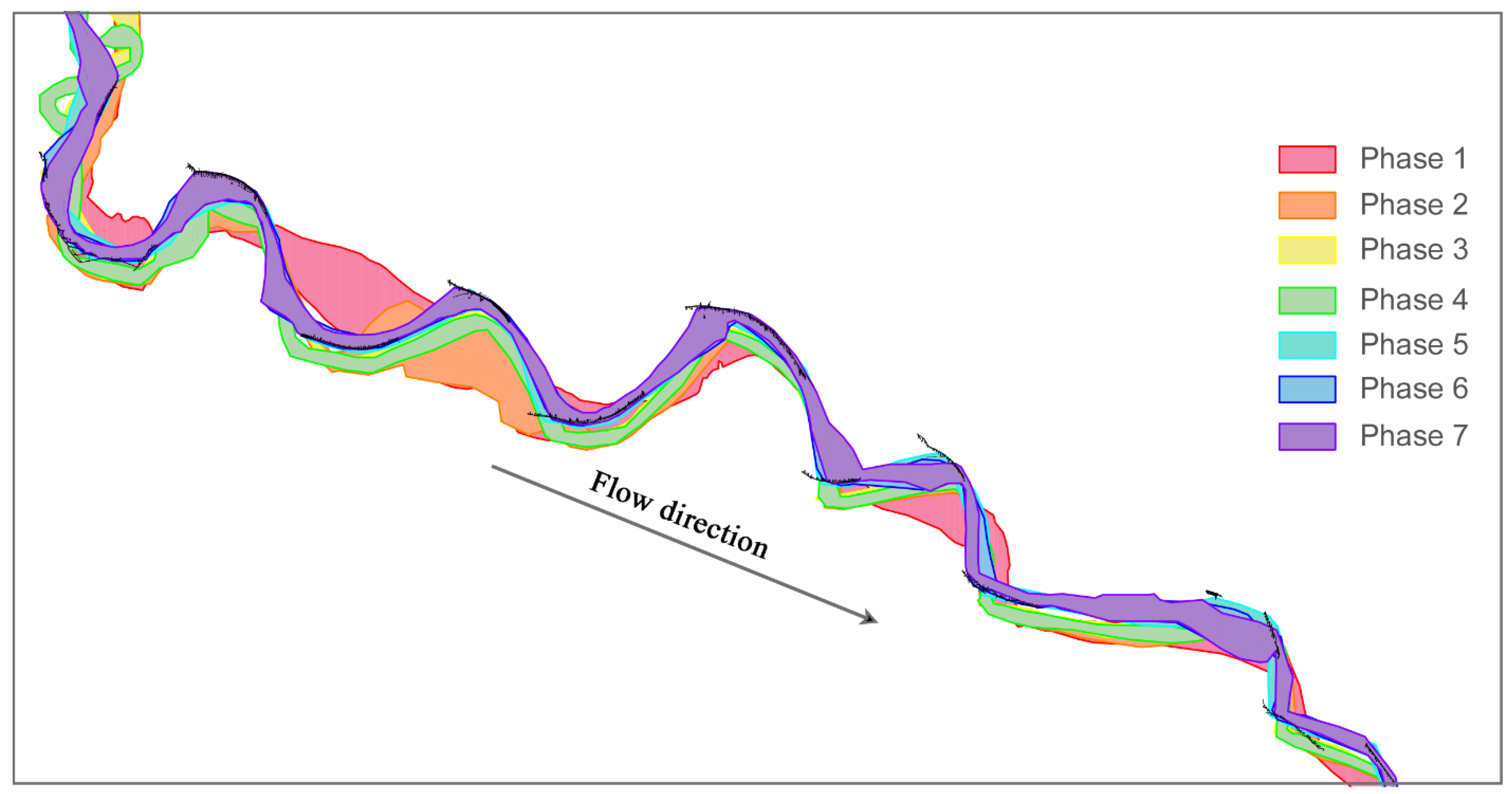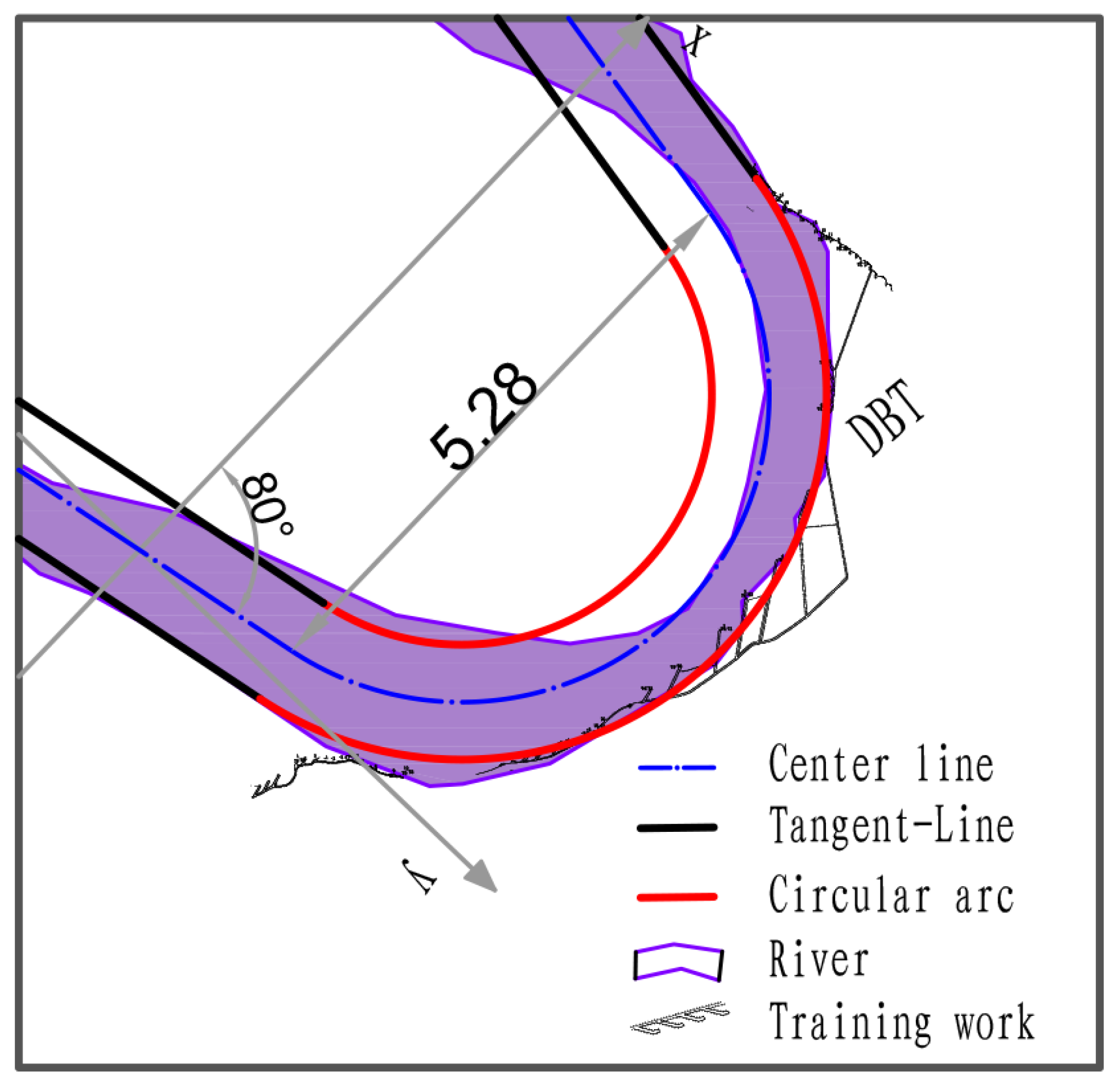An Improved Method and the Theoretical Equations for River Regulation Lines
Abstract
:1. Introduction
2. Study Area and Data Sources
2.1. Study Area
2.2. Data Sources
3. Methods
3.1. Trend Testing and Turning Point Identification
3.2. Bank Line Variation
3.3. Theoretical Equations of the River Regulation Lines
3.3.1. Equations of the Parabola
3.3.2. Equations of the Circular Arcs and Tangent Lines
3.3.3. Equations of the Elliptical Arcs and Tangent Lines
3.3.4. Equations of the Elliptical Arcs, Curvature Circular Arcs, and Tangent Lines
4. Results
4.1. Investigation on Variation Trends of Runoff and Sediment Transport
4.2. Analysis of River Regimes Evolution in Wandering Reach of Yellow River
4.3. Verification of the Theoretical Equations of the River Regulation Lines
4.3.1. The SJ–SZ Reach
4.3.2. The DBT Bend
4.3.3. The GBZ bend
4.3.4. The DYL Bend
5. Discussion
5.1. Planning and Design of River Regulation Lines Using the Traditional Method
5.2. Comparison of the New and Traditional Methods
6. Conclusions
Author Contributions
Funding
Institutional Review Board Statement
Informed Consent Statement
Data Availability Statement
Conflicts of Interest
References
- Plink-Björklund, P. Stacked fluvial and tide-dominated estuarine deposits in high-frequency (fourth-order) sequences of the Eocene Central Basin, Spitsbergen. Sedimentology 2005, 52, 391–428. [Google Scholar] [CrossRef]
- Lunt, I.A.; Bridge, J.S.; Tye, R.S. A quantitative, three-dimensional depositional model of gravelly braided rivers. Sedimentology 2004, 51, 377–414. [Google Scholar] [CrossRef]
- Schumm, S.A.; Dumont, J.; Holbrook, J. Active Tectonics and Alluvial Rivers; Cambridge University Press: Cambridge, UK, 2000; pp. 270–276. [Google Scholar]
- Chen, W.; Xu, Q.; Ma, Y.; Zhang, X. Palaeochannels on the north china plain: Palaeoriver geomorphology. Geomorphology 1996, 18, 37–45. [Google Scholar] [CrossRef]
- Herbert, G. Sequence stratigraphic analysis of early and middle Triassic alluvial and estuarine fades in the Sydney Basin, Australia. Aust. J. Earth Sci. 1997, 44, 125–143. [Google Scholar] [CrossRef]
- Žibret, G.; Gosar, M. Calculation of the mercury accumulation in the Idrijca River alluvial plain sediments. Sci. Total. Environ. 2006, 368, 291–297. [Google Scholar] [CrossRef]
- Latrubesse, E.M.; Franzinelli, E. The Holocene alluvial plain of the middle Amazon River, Brazil. Geomorphology 2002, 44, 241–257. [Google Scholar] [CrossRef]
- Wang, S.; Yan, Y.; Li, Y. Spatial and temporal variations of suspended sediment deposition in the alluvial reach of the upper Yellow River from 1952 to 2007. Catena 2012, 92, 30–37. [Google Scholar] [CrossRef]
- Wang, S.; Fu, B.; Piao, S.; Lü, Y.; Ciais, P.; Feng, X.; Wang, Y. Reduced sediment transport in the Yellow River due to anthropogenic changes. Nat. Geosci. 2016, 9, 38–41. [Google Scholar] [CrossRef]
- Schumm, S.A. Patterns of alluvial rivers. Annu. Rev. Earth Planet. Sci. 1985, 13, 5–27. [Google Scholar] [CrossRef]
- Nanson, G.C.; Knighton, A. Anabranching rivers: Their cause, character and classification. Earth Surf. Process. Landf. 1994, 21, 217–239. [Google Scholar] [CrossRef]
- Carling, P.; Jansen, J.; Meshkova, L. Multichannel rivers: Their definition and classification. Earth Surf. Process. Landf. 2013, 39, 26–37. [Google Scholar] [CrossRef]
- Liu, Y.; Wang, Y.; Jiang, E. Stability index for the planview morphology of alluvial rivers and a case study of the Lower Yellow River. Geomorphology 2021, 389, 107853. [Google Scholar] [CrossRef]
- Kondolf, G.M.; Gao, Y.; Annandale, G.W.; Morris, G.L.; Jiang, E.; Zhang, J.; Cao, Y.; Carling, P.; Fu, K.; Guo, Q.; et al. Sustainable sediment management in reservoirs and regulated rivers: Experiences from five continents. Earths Future 2014, 2, 256–280. [Google Scholar] [CrossRef]
- Tu, Q.H.; An, C.; Qing, Z.; Zhang, S.; Zhang, H. Riverbed evolution of the lower Yellow River and water and sediment regulation by Xiaolangdi Reservoir. River Sediment. Theory Appl. 1999, 24, 855–860. [Google Scholar]
- Yin, S.; Gao, G.; Ran, L.; Lu, X.; Fu, B. Spatiotemporal Variations of Sediment Discharge and In-Reach Sediment Budget in the Yellow River from the Headwater to the Delta. Water Resour. Res. 2021, 57, e2021WR030130. [Google Scholar] [CrossRef]
- Milly, P.C.D.; Dunne, K.A.; Vecchia, A.V. Global pattern of trends in streamflow and water availability in a changing climate. Nature 2005, 438, 347–350. [Google Scholar] [CrossRef]
- Oki, T.; Kanae, S. Global Hydrological Cycles and World Water Resources. Science 2006, 313, 1068–1072. [Google Scholar] [CrossRef] [Green Version]
- Li, Y.; Chang, J.; Tu, H.; Wang, X. Impact of the Sanmenxia and Xiaolangdi Reservoirs Operation on the Hydrologic Regime of the Lower Yellow River. J. Hydrol. Eng. 2016, 21, 06015015. [Google Scholar] [CrossRef]
- Maren, D.; Ming, Y.; Zheng, B. Predicting the morphodynamic response of silt-laden rivers to water and sediment release from reservoirs: Lower yellow river, China. J. Hydrol. Eng. 2010, 137, 900–999. [Google Scholar]
- Ma, L.; Zhang, H.; Zhong, D. Design of regulation line based on check and balance mechanism. J. Hydrol. Eng. 2016, 47, 1315–1321. [Google Scholar]
- Zhang, H.W.; Zhang, J.; Zhong, D.; Bu, H. Regulation strategies for wandering reaches of Lower Yellow River. J. Hydraul. Eng. 2011, 42, 8–13. [Google Scholar]
- Guo, Y.; Li, C.; Wang, C.; Xu, J.; Jin, C.; Yang, S. Sediment routing and anthropogenic impact in the Huanghe River catchment, China: An investigation using Nd isotopes of river sediments. Water Resour. Res. 2021, 57, e2020WR028444. [Google Scholar] [CrossRef]
- Su, T.; Huang, H.Q.; Carling, P.A.; Yu, G.; Nanson, G.C. Channel-Form Adjustment of an Alluvial River Under Hydrodynamic and Eco-Geomorphologic Controls: Insights from Applying Equilibrium Theory Governing Alluvial Channel Flow. Water Resour. Res. 2021, 57, e2020WR029174. [Google Scholar] [CrossRef]
- Wu, X.; Wang, H.; Bi, N.; Xu, J.; Nittrouer, J.; Yang, Z. Impact of artificial floods on the quantity and grain size of riv-er-borne sediment: A case study of a dam regulation scheme in the Yellow River catchment. Water Resour. Res. 2021, 57, e2021WR029581. [Google Scholar] [CrossRef]
- Yang, Z.; Wang, H.; Saito, Y.; Milliman, J.D.; Xu, K.; Qiao, S.; Shi, G. Dam impacts on the Changjiang (Yangtze) River sediment discharge to the sea: The past 55 years and after the Three Gorges Dam. Water Resour. Res. 2006, 42, W04407. [Google Scholar] [CrossRef]
- Xu, J.; Ma, Y. Response of the hydrological regime of the Yellow River to the changing monsoon intensity and human activity. Hydrol. Sci. J. 2009, 54, 90–100. [Google Scholar] [CrossRef]
- Jiang, C.; Xiong, L.; Guo, S.; Xia, J.; Xu, C.-Y. A process-based insight into nonstationarity of the probability distribution of annual runoff. Water Resour. Res. 2017, 53, 4214–4235. [Google Scholar] [CrossRef] [Green Version]
- Cong, Z.; Yang, D.; Gao, B.; Yang, H.; Hu, H. Hydrological trend analysis in the Yellow River basin using a distributed hydro-logical model. Water Resour. Res. 2009, 45, 7. [Google Scholar] [CrossRef]
- Yan, J.; Liang, B.; Cao, H.; Zhang, Y.H. BP Model Used for Calculating the High Efficient Sediment-Transport Water Volume in the Lower Yellow River. Adv. Mater. Res. 2011, 225, 1345–1349. [Google Scholar] [CrossRef]
- Pan, B.; Han, M.; Wei, F.; Tian, L.X.; Liu, Y.T.; Li, Y.; Wang, M. Analysis of the Variation Characteristics of Runoff and Sediment in the Yellow River Within 70 Years. Water Resour. 2021, 48, 676–689. [Google Scholar] [CrossRef]
- Wang, H.; Sun, F. Variability of annual sediment load and runoff in the Yellow River for the last 100 years (1919–2018). Sci. Total. Environ. 2020, 758, 143715. [Google Scholar] [CrossRef] [PubMed]
- Li, W.; Fu, X.; Wu, W.; Wu, B. Study on runoff and sediment process variation in the lower yellow river. J. Hydroelectr. Eng. 2014, 33, 108–113. [Google Scholar] [CrossRef]
- Zhang, X.; Song, C.; Hu, D. Research on the periodic regularity of annual runoff in the Lower Yellow River. J. Water Clim. Chang. 2018, 10, 130–141. [Google Scholar] [CrossRef]
- Gao, P.; Mu, X.-M.; Wang, F.; Li, R. Changes in streamflow and sediment discharge and the response to human activities in the middle reaches of the Yellow River. Hydrol. Earth Syst. Sci. 2011, 15, 1–10. [Google Scholar] [CrossRef]
- Xu, J. Effect of human activities on overall trend of sedimentation in the lower yellow river, China. Environ. Manag. 2004, 33, 637–653. [Google Scholar]
- Cavadias, G. Detection and modeling of the impact of climatic change on riverflows. In Engineering Risk in Natural Resources Management; Springer: Berlin/Heidelberg, Germany, 1994; pp. 207–218. [Google Scholar]
- Pirani, F.J.; Najafi, M. Recent trends in individual and multivariate compound flood drivers in Canada’s coasts. Water Resour. Res. 2020, 56, e2020WR027785. [Google Scholar]
- Wrzesinski, D.; Ptak, M. Water level changes in Polish lakes during 1976–2010. J. Geogr. Sci. 2016, 26, 83–101. [Google Scholar] [CrossRef] [Green Version]
- Asfaw, A.; Simane, B.; Hassen, A.; Bantider, A. Variability and time series trend analysis of rainfall and temperature in northcentral Ethiopia: A case study in Woleka sub-basin. Weather. Clim. Extrem. 2018, 19, 29–41. [Google Scholar] [CrossRef]
- Strohmenger, L.; Fovet, O.; Akkal-Corfini, N.; Dupas, R.; Durand, P.; Faucheux, M. Multitemporal relationships between the hydroclimate and exports of carbon, nitrogen, and phosphorus in a small agricultural watershed. Water Resour. Res. 2020, 56, e2019WR026323. [Google Scholar] [CrossRef]
- Xu, K.; Milliman, J.D.; Xu, H. Temporal trend of precipitation and runoff in major Chinese Rivers since 1951. Glob. Planet. Chang. 2010, 73, 219–232. [Google Scholar] [CrossRef]
- Kisi, O.; Haktanir, T.; Ardiclioglu, M.; Ozturk, O.; Yalcin, E.; Uludag, S. Adaptive neuro-fuzzy computing technique for sus-pended sediment estimation. Adv. Eng. Softw. 2009, 40, 438–444. [Google Scholar] [CrossRef]
- Zhang, L.Z.; Wan, Q.; Huang, H. The Statistical Law of Regulation Parameters of the Meandering Channel in the Lower Yellow River. In Proceedings of the 4th International Yellow River Forum on Ecological Civilization and River Ethics V, Zhengzhou, China, 20–23 October 2009; pp. 198–201. [Google Scholar]
- Li, Y.Q.; Wang, B.; Liu, Y. Research on Applicability of Lower Yellow River Training Works after Beginning of Xiaolangdi Reservoir Operation. In Proceedings of the 2012 International Conference on Modern Hydraulic Engineering, Nanjing, China, 9–11 March 2012; Volume 28, pp. 776–780. [Google Scholar]
- Zhang, C.P.; Zhang, R.; Jiang, N.; Hu, T. Review on planned and revised alignments of channel regulation in the lower Weihe river. J. Sediment Res. 2009, 5, 47–51. [Google Scholar]
- Wu, B.; Ma, J.; Zhang, B.; Ma, J. Morphological Response to River Training in the Lower Yellow River. In Proceedings of the 1st International Yellow River Forum on River Basin Management, Zhengzhou, China, 21–24 October 2003; Volume 2. [Google Scholar]
- Mann, H.B. Nonparametric tests against trend. Econometrica 1945, 13, 245–259. [Google Scholar] [CrossRef]
- Kendall, M.G. Rank Correlation Methods; Griffin: London, UK, 1975. [Google Scholar]
- Yue, S.; Pilon, P. A comparison of the power of the t-test, Mann-Kendall and bootstrap tests for trend detection/Une comparaison de la puissance des tests t de Student, de Mann-Kendall et du bootstrap pour la détection de tendance. Hydrol. Sci. J. 2004, 49, 21–37. [Google Scholar] [CrossRef]
- Hirsch, R.M.; Slack, J.R.; Smith, R.A. Techniques of trend analysis for monthly water-quality data. Water Resour. Res. 1981, 18, 107–121. [Google Scholar] [CrossRef] [Green Version]
- Gan, T.Y. Finding Trends in Air Temperature and Precipitation for Canada and Northeastern United States. In Using Hydrometric Data to Detect and Monitor Climate Change; NHRI Workshop No. 8; National Hydrology Research Institute: Saskatoon, SK, Canada, 1992; pp. 57–78. [Google Scholar]
- Hamed, K.H.; Raom, A.R. A modified Mann-Kendall trend test for autocorrelated data. J. Hydrol. 1998, 204, 182–196. [Google Scholar] [CrossRef]
- Pour, S.H.; Abd Wahab, A.K.; Shahid, S. Spatial pattern of the unidirectional trends in thermal bioclimatic indicators in Iran. Sustainability 2019, 11, 2287. [Google Scholar] [CrossRef]
- Alhaji, U.U.; Yusuf, A.S.; Edet, C.O.; Oche, C.O.; Agbo, E.P. Trend Analysis of Temperature in Gombe State Using Mann Kendall Trend Test. J. Sci. Res. Rep. 2018, 20, 1–9. [Google Scholar] [CrossRef]
- Xing, L.; Huang, L.; Chi, G.; Yang, L.; Li, C.; Hou, X. A Dynamic Study of a Karst Spring Based on Wavelet Analysis and the Mann-Kendall Trend Test. Water 2018, 10, 698. [Google Scholar] [CrossRef] [Green Version]
- Lv, X.; Zuo, Z.; Ni, Y.; Sun, J.; Wang, H. The effects of climate and catchment characteristic change on streamflow in a typical tributary of the Yellow River. Sci. Rep. 2019, 9, 1–10. [Google Scholar] [CrossRef] [Green Version]
- Liang, K.; Liu, C.; Liu, X. Impacts of climate variability and human activity on streamflow decrease in a sediment con-centrated region in the Middle Yellow River. Stoch. Environ. Res. Risk Assess. 2013, 27, 1741–1749. [Google Scholar] [CrossRef]
- Mukhopadhyay, A.; Mukherjee, S.; Mukherjee, S.; Ghosh, S.; Hazra, S.; Mitra, D. Automatic shoreline detection and future prediction: A case study on Puri Coast, Bay of Bengal, India. Eur. J. Remote Sens. 2012, 45, 201–213. [Google Scholar] [CrossRef]
- Simonsen, L.; Gordon, D.M.; Stewart, F.M. Estimating the rate of plasmid transfer: An end-point method. Microbiology 1990, 136, 2319–2325. [Google Scholar] [CrossRef] [PubMed]
- Avner, F. Partial Differential Equations of Parabolic Type; Courier Dover Publications: Mineola, NY, USA, 2008. [Google Scholar]
- Bettina, R.; Richmond, T. How to recognize a parabola. Am. Math. Mon. 2009, 116, 910–922. [Google Scholar]
- Kazimierz, J. Approximation of Smooth Planar Curves by Circular arc Splines. 2012. Available online: http://kaj.uniwersytetradom.pl/prace/Biarcs.pdf (accessed on 11 November 2022).
- Qing, H.; Lin, F. Elliptic partial differential equations. Am. Math. Soc. 2011, 1, 147. [Google Scholar]
- Mishra, R.B.; Nagireddy, S.R.; Bhattacharjee, S.; Hussain, A.M. Theoretical Modeling and Numerical Simulation of Elliptical Capacitive Pressure Microsensor. In Proceedings of the 2019 IEEE Conference on Modeling of Systems Circuits and Devices (MOS-AK India), Hyderabad, India, 25–27 February 2019; pp. 17–22. [Google Scholar]


















| Wandering Reach | Length of Channel (km) | Width of Embankment (km) | Width of Channel (km) | Width of Beach Land (km) | Mean Grade of Slope (‰) |
|---|---|---|---|---|---|
| No.1 | 93 | 4.1–10.0 | 3.1–10.0 | 0.5–5.7 | 0.256 |
| No.2 | 136 | 5.5–12.7 | 1.5–7.2 | 0.3–7.1 | 0.203 |
| No.3 | 70 | 5.0–20.0 | 2.2–6.5 | 0.4–8.7 | 0.172 |
| Item of Statistical Analysis | Direction | SJ–SZ Reach | DBT Bend | GBZ Bend | DYL Bend |
|---|---|---|---|---|---|
| Mean Value (km) | x-axis | 0.20 | 0.18 | 0.14 | 0.19 |
| y-axis | 0.30 | 0.31 | 0.40 | 0.14 | |
| Standard Deviation (km) | x-axis | 0.155 | 0.142 | 0.085 | 0.111 |
| y-axis | 0.299 | 0.316 | 0.210 | 0.113 |
| Item of Statistical Analysis | Direction | Traditional River Regulation Lines | New River Regulation Lines |
|---|---|---|---|
| Mean Value (km) | x-axis | 0.72 | 0.50 |
| y-axis | 0.65 | 0.49 | |
| Standard Deviation (km) | x-axis | 0.548 | 0.525 |
| y-axis | 0.310 | 0.263 |
Disclaimer/Publisher’s Note: The statements, opinions and data contained in all publications are solely those of the individual author(s) and contributor(s) and not of MDPI and/or the editor(s). MDPI and/or the editor(s) disclaim responsibility for any injury to people or property resulting from any ideas, methods, instructions or products referred to in the content. |
© 2023 by the authors. Licensee MDPI, Basel, Switzerland. This article is an open access article distributed under the terms and conditions of the Creative Commons Attribution (CC BY) license (https://creativecommons.org/licenses/by/4.0/).
Share and Cite
Li, L.; Zhang, H.; Hou, L.; Li, H. An Improved Method and the Theoretical Equations for River Regulation Lines. Sustainability 2023, 15, 1965. https://doi.org/10.3390/su15031965
Li L, Zhang H, Hou L, Li H. An Improved Method and the Theoretical Equations for River Regulation Lines. Sustainability. 2023; 15(3):1965. https://doi.org/10.3390/su15031965
Chicago/Turabian StyleLi, Linqi, Hongwu Zhang, Lin Hou, and Haobo Li. 2023. "An Improved Method and the Theoretical Equations for River Regulation Lines" Sustainability 15, no. 3: 1965. https://doi.org/10.3390/su15031965






